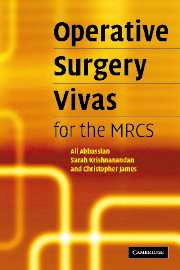Book contents
- Frontmatter
- Contents
- Preface
- 1 The elective repair of an abdominal aortic aneurysm
- 2 Adrenalectomy
- 3 Amputation (below knee)
- 4 Anorectal abscesses, fistulae and pilonidal sinus
- 5 Appendicectomy
- 6 Principles of bowel anastomosis
- 7 Breast surgery
- 8 Carotid endarterectomy
- 9 Carpal tunnel decompression
- 10 Central venous cannulation
- 11 Cholecystectomy (laparoscopic)
- 12 Circumcision
- 13 Colles' fracture (closed reduction of)
- 14 Compound fractures
- 15 Dupuytren's contracture release
- 16 Dynamic hip screw
- 17 Fasciotomy for compartment syndrome
- 18 Femoral embolectomy
- 19 Femoral hernia repair
- 20 Haemorrhoidectomy
- 21 Hip surgery
- 22 Hydrocele repair
- 23 The open repair of an inguinal hernia
- 24 Laparotomy and abdominal incisions
- 25 Oesophago-gastroduodenoscopy
- 26 Orchidectomy
- 27 Parotidectomy
- 28 Perforated peptic ulcer
- 29 Pyloric stenosis and Ramstedt's pyloromyotomy
- 30 Right hemicolectomy
- 31 Skin cover (the reconstructive ladder)
- 32 Spinal procedures
- 33 Splenectomy
- 34 Stomas
- 35 Submandibular gland excision
- 36 Tendon repairs
- 37 Thoracostomy (insertion of a chest drain)
- 38 Thoracotomy
- 39 Thyroidectomy
- 40 Tracheostomy
- 41 Urinary retention and related surgical procedures
- 42 Varicose vein surgery
- 43 Vasectomy
- 44 Zadik's procedure
23 - The open repair of an inguinal hernia
Published online by Cambridge University Press: 16 October 2009
- Frontmatter
- Contents
- Preface
- 1 The elective repair of an abdominal aortic aneurysm
- 2 Adrenalectomy
- 3 Amputation (below knee)
- 4 Anorectal abscesses, fistulae and pilonidal sinus
- 5 Appendicectomy
- 6 Principles of bowel anastomosis
- 7 Breast surgery
- 8 Carotid endarterectomy
- 9 Carpal tunnel decompression
- 10 Central venous cannulation
- 11 Cholecystectomy (laparoscopic)
- 12 Circumcision
- 13 Colles' fracture (closed reduction of)
- 14 Compound fractures
- 15 Dupuytren's contracture release
- 16 Dynamic hip screw
- 17 Fasciotomy for compartment syndrome
- 18 Femoral embolectomy
- 19 Femoral hernia repair
- 20 Haemorrhoidectomy
- 21 Hip surgery
- 22 Hydrocele repair
- 23 The open repair of an inguinal hernia
- 24 Laparotomy and abdominal incisions
- 25 Oesophago-gastroduodenoscopy
- 26 Orchidectomy
- 27 Parotidectomy
- 28 Perforated peptic ulcer
- 29 Pyloric stenosis and Ramstedt's pyloromyotomy
- 30 Right hemicolectomy
- 31 Skin cover (the reconstructive ladder)
- 32 Spinal procedures
- 33 Splenectomy
- 34 Stomas
- 35 Submandibular gland excision
- 36 Tendon repairs
- 37 Thoracostomy (insertion of a chest drain)
- 38 Thoracotomy
- 39 Thyroidectomy
- 40 Tracheostomy
- 41 Urinary retention and related surgical procedures
- 42 Varicose vein surgery
- 43 Vasectomy
- 44 Zadik's procedure
Summary
How would you distinguish a direct from an indirect inguinal hernia?
Anatomically: A direct inguinal hernia protrudes through the posterior wall of the inguinal canal medial to the inferior epigastric artery, whereas an indirect hernia emerges from the deep inguinal ring lateral to it.
Clinically: An indirect inguinal hernia may be controlled by applying pressure on the abdominal wall at the site of the deep inguinal ring surface marking: 1.5 cm above the midpoint of the inguinal ligament (midpoint of a line drawn from the pubic tubercle to the anterior superior iliac spine).
Note: Not the midinguinal point (see Chapter 18, Femoral embolectomy).
What is the difference between an obstructed and a strangulated hernia?
An obstructed hernia contains obstructed but viable bowel, whereas a strangulated hernia may contain non-viable bowel since its venous drainage is compromised.
What pre-operative measures should be taken before the repair of an inguinal hernia?
Consider general versus local anaesthetic. The procedure under a local anaesthetic is generally not advised in the anxious patient and in the obese patient. It is contraindicated in suspected strangulated herniae (where a more extensive dissection may be required).
Consider an open versus laparoscopic repair. Laparoscopic repairs are generally chosen for bilateral or recurrent herniae.
Two units of blood should be cross-matched and perioperative intravenous antibiotics (e.g. Cefotaxime and Metronidazole) should be given in cases of strangulated herniae.
- Type
- Chapter
- Information
- Operative Surgery Vivas for the MRCS , pp. 85 - 88Publisher: Cambridge University PressPrint publication year: 2006



